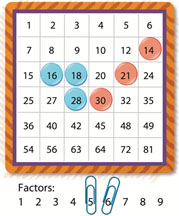Product Game

How To Play
This is a two-player or two-team game.
The game involves a paper board with the numbers listed on a six by six grid. The numbers are all of the products of the factors shown at the bottom of the board. Players take turns moving one of the pointers (paper clips) on the factors. The product is then covered or circled on the board. The first player to have four in a row wins.
Goal
As the game is played several times, students look for patterns to make better choices for choosing a number.
In the process, they are developing and reinforcing their knowledge of multiplication and division as inverse operations, factors, and products. Analyzing the game can also reinforce their understanding of basic number theory including prime and composite numbers, abundant and deficient numbers, and square numbers. If playing with the integer game board, students practice multiplying and dividing with negative and positive numbers.
Game options include changing the factors in play or changing the number in a row to win. For example, the factors can include both negative and positive numbers.
Materials
-
Product Game Board to be used for one game
You can print a Labsheet or make one by listing the numbers shown on the Labsheet in a six by six grid. Two versions of the game are available: one with whole numbers and one with negative and positive numbers (integers). - Pens, pencils, markers, or small pieces of paper for players to mark their numbers on the game board
- 2 paper clips or some other way to point to the factors being used.
- The game can also be played electronically with more game board options. (Electronic Option 1 | Electronic Option 2)
Rules
This is a game for two players or two teams.
- Player A puts a paper clip on a number in the factor list.
- Player B puts the other paper clip on any number in the factor list and shades or covers the product of the two factors on the product grid.
- Players can put the paper clips on the same number.
- Player A moves either one of the paper clips to another number in the factor list and then shades or covers the new product with a different color from Player B.
- Each player, in turn, moves a paper clip and marks or covers a product. If a product is already marked or covered, the player does not get a mark for that turn. The winner is the first player to cover four squares in a row—up, down, or diagonally.
Creative Ideas to Enhance the Game
Analyze the products on the board. How do you get each product on the game board? Why are some numbers between 1- 81 missing on the board? Is there a good first move? What are helpful strategies?
Mathematics Involved
Factors, Multiples, Multiplication, Division, Basic number theory